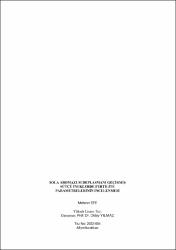Sola abomazum deplasmanı geçirmiş sütçü ineklerde fertilite parametrelerinin incelenmesi
Abstract
Sunulan çalışmada, Holştayn ırkı sütçü ineklerde sola abomazum deplasmanın (LDA) bazı fertilite ve verim parametreleri üzerine etkilerinin ortaya konulması amaçlandı. Primipar ve multipar, ortalama 1,74 ± 0,05 laktasyon sayısına sahip olan toplam 254 adet hayvandan LDA teşhisi konulan ve cerrahi olarak tedavi edilenler deneme (n = 66) grubunu oluştururken, LDA yaşamayan hayvanlar kontrol (n = 188) grubu olarak seçildi. Deneme ve kontrol gruplarında erkek yavru doğumları ile ikiz yavru doğum oranları arasında istatistiksel olarak farklılık izlenmezken, deneme grubundaki dişi yavru doğum oranının, kontrol grubuna göre az, ölü doğum oranının ise yüksek olduğu tespit edildi (p < 0,01). Yavru zarlarının atılamaması, klinik mastitis ve metritis olguları gruplar arasında fark oluşturmazken, deneme grubundaki ortalama kan β-HBA düzeyinin kontrol grubuna göre yüksek olduğu gözlendi (p < 0,01). Laktasyon sayısı (p < 0,01), buzağı cinsiyeti (p < 0,05), ölü doğum (p < 0,05) ve subklinik ketozis (p < 0,001) olgusunun risk faktörü oluşturduğu gözlendi. Ovsynch, Double Ovsynch ve kızgınlık belirtisine göre tohumlamaların yapıldığı çalışmada, deneme grubunda farklı protokollerdeki ilk tohumlamalardan elde edilen gebelik oranları arasında istatistiksel olarak farklılık izlenmedi. Kontrol grubunda Ovsynch protokolü ile elde edilen gebelik oranlarının diğer protokollerden daha yüksek olduğu izlendi (p < 0,01). Deneme grubunda ilk tohumlamalardan sonra elde edilen toplam gebelik oranlarının, kontrol grubuna göre düşük olduğu belirlendi (p < 0,001). Çalışma sonunda, deneme grubunda gebelik başına düşen ortalama tohumlama sayısının (p < 0,01) ve doğum gebe kalma aralığının (p < 0,001) kontrol grubuna göre yüksek, gebelik oranının düşük (p < 0,05) olduğu belirlendi. Deneme grubunun postpartum (pp) ilk 100 gün ve laktasyon boyunca ürettiği ortalama süt veriminin kontrol grubuna göre düşük seyrettiği gözlendi (p < 0,001). Deneme grubunun kuruya ayrılma (p < 0,05) ve sürüyü terk etme (p < 0,01) sürelerinin kontrol grubuna göre daha uzun sürdüğü ve sürüden ayrılma oranının da daha yüksek olduğu gözlendi (p < 0,001).
Sonuç olarak, LDA olgusunun laktasyon sayısı, buzağı cinsiyeti, ölü doğum ve subklinik ketozis ile ilişkili olduğu belirlendi. Bununla birlikte, pp ilk tohumlamalarda düşük gebelik oranlarına sebep olduğu, doğum gebe kalma aralığını ve gebelik başına tohumlama sayısını olumsuz etkilediği, işletmelerde dönen inek olgusuna neden olduğu gözlendi. Gebelik başına tohumlama sayısını ekonomik düzeyde tutmak için LDA olgularında gönüllü bekleme periyodunun pp 100 gün olarak belirlenmesi, bu sırada pp ilk 100 gün süt verimi düşük seyreden hayvanların tohumlama yapmadan sürü dışı edilmesi yaklaşımlarını benimseyerek ekonomik kayıpların azaltılabileceği önerilmektedir. In the present study, it was aimed to reveal the effect of left displaced abomasum (LDA) on some fertility and yield parameters in Holstein dairy cows. Experiment group (n = 66) in which LDA was diagnosed and treated by surgery, was chosen from a total of 254 primiparous or multiparous cows in 1,74 ± 0,05 lactation number on average, whereas the cows diagnosed as healthy were the control group (n = 188). There was no significant difference in terms of male calf and twin births, whereas female birth rate was lower and still birth rate was higher in the experiment group than those detected in the control group (p < 0,01). The rate of placental retention, clinic mastitis and metritis did not show any significant difference between groups, whereas the average concentrations of blood β-HBA were higher in the experiment group (p < 0,01). Lactation number (p < 0,01), calf gender (p < 0,05), stillbirth (p < 0,05) and subclinical ketosis (p < 0,001) were the risk factors. The present study in which artificial insemination (AI) was performed at Ovsynch, Double Ovsynch protocols or standing heat showed that the pregnancy rates obtained from first AI did not differ between groups. The pregnancy rates obtained from Ovsynch protocol was higher than other protocols in the control group (p < 0,01). The total pregnancy rates after first AI in the experiment group were lower than those detected in the control group (p < 0,001). The overall results showed that the average number of AI per pregnancy (p < 0,01) and the calving pregnancy interval (p < 0,001) in the experiment group was lower than those detected in the control group, whereas pregnancy rates were lower (p < 0,05). The average first postpartum (pp) 100 days and lactation milk yield in the experiment group were lower than the milk yield in the control group (p < 0,001). It was observed that the duration of drying-off (p < 0,05) and culling (p < 0,01) in the experiment group were longer and the culling rate was higher than those detected in the control group (p < 0,001).
In conclusion, it was observed that LDA was associated with the lactation number, calf gender, stillbirth and subclinical ketosis. Furthermore, it was seen that the LDA caused lower pregnancy rates at first pp AI, negatively affected the calving pregnancy interval or the number of AI per pregnancy rate and lead to repeat breeder syndrome. It is suggested that the voluntary waiting period should be accepted as pp first 100 days to obtain reliable AI number per pregnancy in LDA cases and the economic loss may be decreased by the culling of cows having low milk yield at pp first 100 days without AI.
Collections
- Yüksek Lisans Tezleri [667]



















